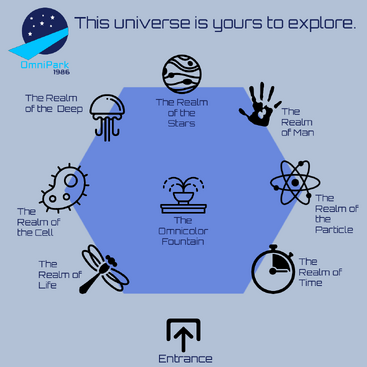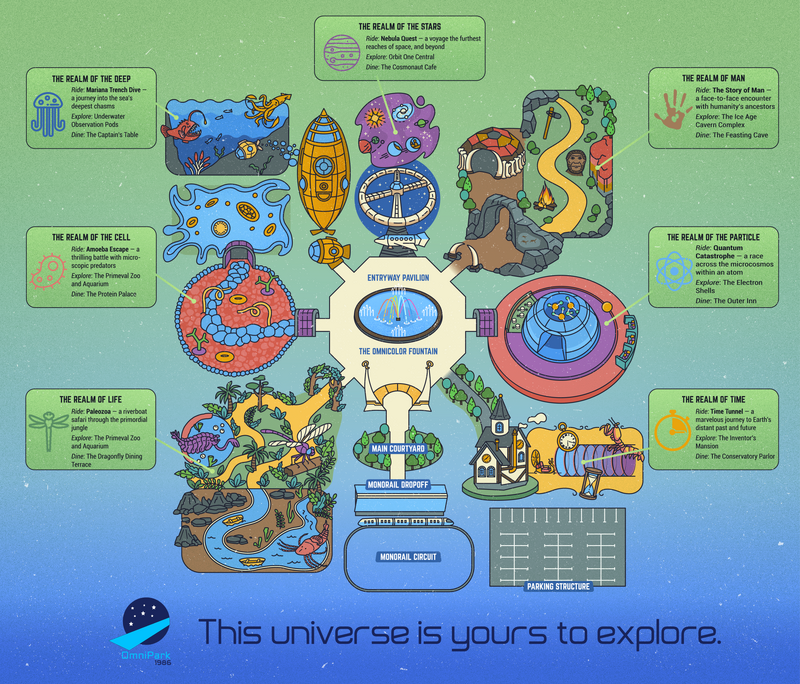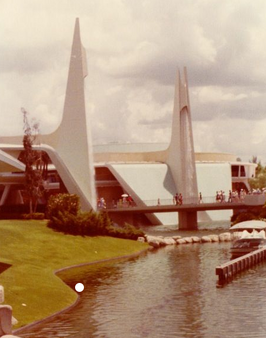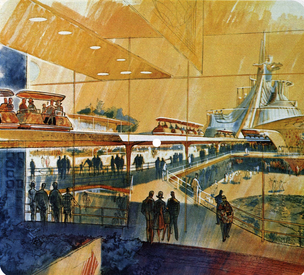Tag: Visual edit |
mNo edit summary Tag: Visual edit |
||
| (25 intermediate revisions by 3 users not shown) | |||
| Line 1: | Line 1: | ||
<mainpage-leftcolumn-start /> |
<mainpage-leftcolumn-start /> |
||
[[File:OmniPark 1986 Map.png|thumb|367x367px]] |
[[File:OmniPark 1986 Map.png|thumb|367x367px]] |
||
| − | <div style="text-align: center; font-size: x-large; padding: 1em;">'''''This universe is yours to explore.''''' |
+ | <div style="text-align: center; font-size: x-large; padding: 1em;">'''''"This universe is yours to explore." ''''' ''OmniPark official motto'' |
| + | </div>'''OmniPark''' was a theme park located near Odessa, Texas from 1977 to 2003. The park was divided into the Seven Realms: |
||
| + | * [[The Realm of Life]] |
||
| + | * [[The Realm of the Cell]] |
||
| + | * [[The Realm of the Deep]] |
||
| + | * [[The Realm of the Stars]] |
||
| + | * [[The Realm of Man]] |
||
| + | * [[The Realm of the Particle]] |
||
| + | * [[The Realm of Time]] |
||
| + | Each Realm was represented by its own distinctive [[OmnIcons|OmnIcon]], and was a complete world unto itself: the environment, shops, restaurants, souvenirs, staff members and every other detail were internally consistent. |
||
| + | [[File:Omnipark 86 Guidemap1.png|none|thumb|800x800px|OmniPark 1986 Guidemap]] |
||
| − | At the center of the Seven Realms stood the Omnicolor Fountain, which put on shows several times a day. |
||
| + | At the center of the Seven Realms stood the [[Omnicolor Fountain|OmniColor Fountain]], which put on shows several times a day. Prior to the construction of the Fountain, this central area was known as the [[Realm Between the Realms]], and contained a private pavilion that served as an exclusive entertainment and lounge area for VIP park guests. |
||
| + | |||
| + | Visitors entered OmniPark through the [[Entryway Pavilion]] — a towering white building often likened to a cathedral. |
||
== History == |
== History == |
||
| + | [[File:Main Pavilion.png|left|thumb|338x338px|OmniPark's original Entryway Pavilion, circa 1977]] |
||
OmniPark was founded by [[Dalton M. Teague]], a Texas oil billionaire who held advanced degrees in engineering and biology. In a 1979 interview with Life Magazine, Teague attributed his original idea for the park to his own wide-ranging scientific interests, as well as to his realization that "California has its Disneyland and Florida has its EPCOT Center — so why shouldn't the great state of Texas have her own world-class theme park?" |
OmniPark was founded by [[Dalton M. Teague]], a Texas oil billionaire who held advanced degrees in engineering and biology. In a 1979 interview with Life Magazine, Teague attributed his original idea for the park to his own wide-ranging scientific interests, as well as to his realization that "California has its Disneyland and Florida has its EPCOT Center — so why shouldn't the great state of Texas have her own world-class theme park?" |
||
| − | Using his own private funds, Teague purchased 120 acres of farmland near Odessa, Texas (for an undisclosed sum) in May 1974. He then hired a core team of "[[Technosophers]]" including engineers [[Harry Peale]] and [[Roger Clarendon]], designers [[Beth Bachmeier]] and [[Elijah Shattuck]], |
+ | Using his own private funds, Teague purchased 120 acres of farmland near Odessa, Texas (for an undisclosed sum) in May 1974. He then hired a core team of "[[Technosophers]]" including engineers [[Harry Peale]] and [[Roger Clarendon]], designers [[Beth Bachmeier]] and [[Elijah Shattuck]], science fiction writer [[Chuck Walcott]], and storyboard artists [[Denise Olivetti]] and [[Takeshi Satsumoto|Yamasato Masaru]]. |
| − | |||
| ⚫ | By spring of 1975, Teague and his team had completed a series of storyboards, architectural blueprints and animatronic designs, through which they secured at least $500 million in investment capital from a variety of public and private sources (several of which have never been disclosed). Through a combination of this capital and Teague family funds, construction on OmniPark began in February of 1975. |
||
| ⚫ | By spring of 1975, Teague and his team had completed a series of storyboards, architectural blueprints and animatronic designs, through which they secured at least $500 million in investment capital from a variety of public and private sources (several of which have never been disclosed'''<sup>[[https://en.wikipedia.org/wiki/Wikipedia:Citation_needed citation needed]]</sup>'''). Through a combination of this capital and Teague family funds, construction on OmniPark began in February of 1975. |
||
| + | [[File:OmniPark.png|thumb|304x304px|1975 concept art for OmniPark's Entryway Pavilion]] |
||
The park's official grand opening was May 19, 1977, and initial attendance was disappointing — a fact Teague blamed on The park's location in West Texas, far from any other tourist destination. In response, Teague invested heavily in a nationwide advertising campaign; and the city of Odessa offered financial incentives to entrepreneurs who founded hotels, restaurants and other tourism-oriented businesses near the park. |
The park's official grand opening was May 19, 1977, and initial attendance was disappointing — a fact Teague blamed on The park's location in West Texas, far from any other tourist destination. In response, Teague invested heavily in a nationwide advertising campaign; and the city of Odessa offered financial incentives to entrepreneurs who founded hotels, restaurants and other tourism-oriented businesses near the park. |
||
| − | Over the next several seasons, a thriving community began to develop in the surrounding area; and by March 1978, OmniPark was hosting upwards of 35,000 guests per day '''[citation needed]'''. The park remained one of the Southwest's most popular tourist destinations for the next 25 years, until its official closing in August 2003. |
+ | Over the next several seasons, a thriving community began to develop in the surrounding area; and by March 1978, OmniPark was hosting upwards of 35,000 guests per day '''<sup>[[https://en.wikipedia.org/wiki/Wikipedia:Citation_needed citation needed]]</sup>'''. The park remained one of the Southwest's most popular tourist destinations for the next 25 years, until its official closing in August 2003. |
== The Seven Realms == |
== The Seven Realms == |
||
| − | <gallery position="center" captionalign="center" navigation="true"> |
+ | <gallery position="center" captionalign="center" navigation="true" widths="100" spacing="small"> |
The Realm of Time.png|The Realm of Time|link=https://omnipark.fandom.com/wiki/The_Realm_of_Time |
The Realm of Time.png|The Realm of Time|link=https://omnipark.fandom.com/wiki/The_Realm_of_Time |
||
Jupiter-planet-science-solar-system-512.png|The Realm of the Stars|link=https://omnipark.fandom.com/wiki/The_Realm_of_the_Stars |
Jupiter-planet-science-solar-system-512.png|The Realm of the Stars|link=https://omnipark.fandom.com/wiki/The_Realm_of_the_Stars |
||
| Line 27: | Line 40: | ||
</gallery> |
</gallery> |
||
| − | <!-- The gallery above works well for individual articles, but it would also be good to have another below it that points to important Category: pages. --> |
+ | == Controversy and Park Closure ==<!-- The gallery above works well for individual articles, but it would also be good to have another below it that points to important Category: pages. --> |
[[Category:Browse]] |
[[Category:Browse]] |
||
Revision as of 22:31, 12 July 2020

- The Realm of Life
- The Realm of the Cell
- The Realm of the Deep
- The Realm of the Stars
- The Realm of Man
- The Realm of the Particle
- The Realm of Time
Each Realm was represented by its own distinctive OmnIcon, and was a complete world unto itself: the environment, shops, restaurants, souvenirs, staff members and every other detail were internally consistent.

OmniPark 1986 Guidemap
At the center of the Seven Realms stood the OmniColor Fountain, which put on shows several times a day. Prior to the construction of the Fountain, this central area was known as the Realm Between the Realms, and contained a private pavilion that served as an exclusive entertainment and lounge area for VIP park guests.
Visitors entered OmniPark through the Entryway Pavilion — a towering white building often likened to a cathedral.
History

OmniPark's original Entryway Pavilion, circa 1977
OmniPark was founded by Dalton M. Teague, a Texas oil billionaire who held advanced degrees in engineering and biology. In a 1979 interview with Life Magazine, Teague attributed his original idea for the park to his own wide-ranging scientific interests, as well as to his realization that "California has its Disneyland and Florida has its EPCOT Center — so why shouldn't the great state of Texas have her own world-class theme park?"
Using his own private funds, Teague purchased 120 acres of farmland near Odessa, Texas (for an undisclosed sum) in May 1974. He then hired a core team of "Technosophers" including engineers Harry Peale and Roger Clarendon, designers Beth Bachmeier and Elijah Shattuck, science fiction writer Chuck Walcott, and storyboard artists Denise Olivetti and Yamasato Masaru.
By spring of 1975, Teague and his team had completed a series of storyboards, architectural blueprints and animatronic designs, through which they secured at least $500 million in investment capital from a variety of public and private sources (several of which have never been disclosed[citation needed]). Through a combination of this capital and Teague family funds, construction on OmniPark began in February of 1975.

1975 concept art for OmniPark's Entryway Pavilion
The park's official grand opening was May 19, 1977, and initial attendance was disappointing — a fact Teague blamed on The park's location in West Texas, far from any other tourist destination. In response, Teague invested heavily in a nationwide advertising campaign; and the city of Odessa offered financial incentives to entrepreneurs who founded hotels, restaurants and other tourism-oriented businesses near the park.
Over the next several seasons, a thriving community began to develop in the surrounding area; and by March 1978, OmniPark was hosting upwards of 35,000 guests per day [citation needed]. The park remained one of the Southwest's most popular tourist destinations for the next 25 years, until its official closing in August 2003.





